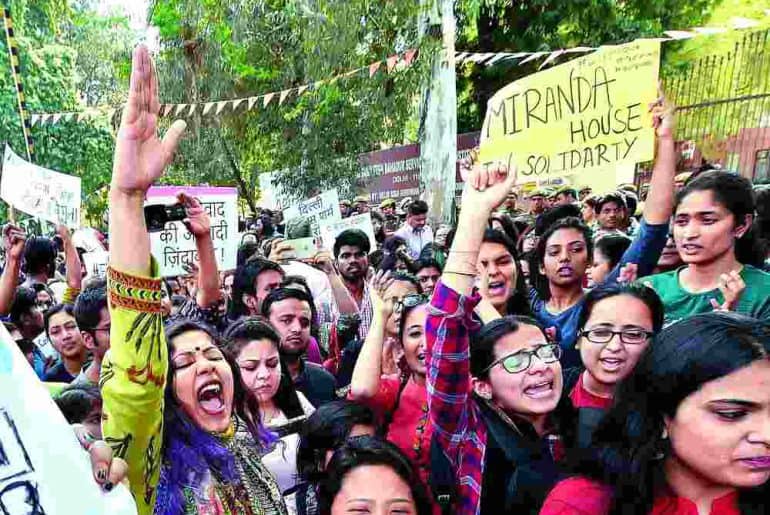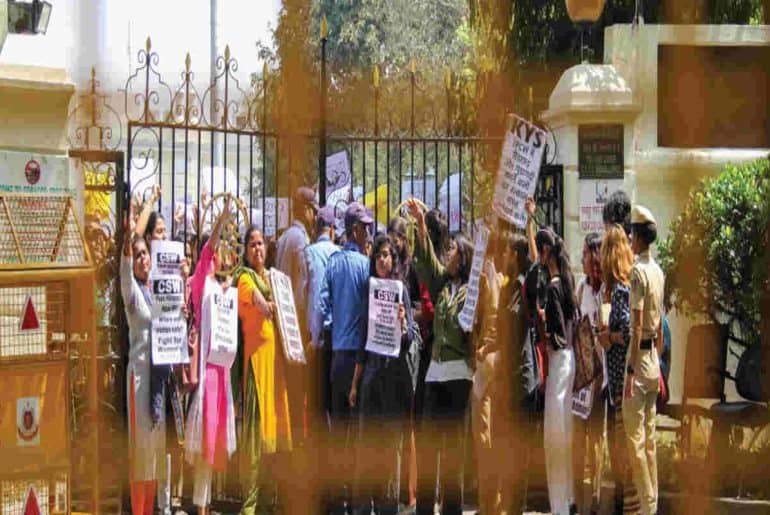This is a narrative of dissent, dissatisfaction, and a culture of resistance.
On a sunny winter morning, five young women sit on the bricked steps of Miranda House (MH) with a single tiffin in their hands. Inside the tiffin are meagre portions of flaxen Lauki and three stiff rotis. This is food they have collected from the hostel mess, and it is food, they decide, that must be served to the college principal. Not out of the graciousness of their hearts but out of an overwrought sense of frustration that they allege has been building up since their first semester at the Miranda House hostel.
Dissent runs rampant in the history of the hostel. The Pinjra Tod movement arrived at its gates in 2018. Demands for the removal of curfews were initially met with a pity extension of 30 minutes. Today, the MH hostel stands as one of the only DU hostels that does not lock up its women at night. The strain of resistance that went into this achievement belongs solely to its residents. Today, however, it has been reduced to a tussle for basic necessities.
Food. It is truly as basic as it gets. The major grievances put forward by the hostel residents include two-pronged complaints of quality and quantity. General complaints of food quality have now pervaded the hostel for quite some time, with instances of people falling ill after having consumed the mess food. In one instance of the burner supposedly having broken down, the residents claim to have been served partially cooked chicken, paneer, and later burned food. On the other hand, I am told that food getting over before the end of meal times is a regular occurrence.
Even as I write this piece, a message circulates in the hostel WhatsApp groups about “uncooked aloo” having been served for dinner. At night, under the lofty palm trees that feature vibrantly in every single equally vibrant photograph of the illustrious institution, residents sit and compare the circumferential edibility of the rotis. Some claim to have stopped eating in the mess altogether.
These grievances are met with rationalisations on the part of the authorities, which residents cite as ranging from “taste is subjective” to, at times, blatant denial. While the gallows-humour approach adopted by the residents is indeed laudable, what of those who cannot afford to eat outside? Must they be punished for entrusting reliance on promised subsidised food and quality residence? A second-year resident aptly asks,
After such a competition to get a seat in the hostel, why do we have to face issues regarding basic things on a regular basis?
Hostellers claim that they are reminded, upon complaints, that they are paying less and hence should learn to adjust. While a comparative analysis of hostel fees in the North Campus domain confirms the assertion that the 27000 (rough per semester standardisation) being paid by Miranda Hostellers is indeed moderate, whether nominal fees are justification enough for compromise on basic tenets of existence is left to the discretion of the reader.
To track the quality of water, some residents recounted a diarrhoea outbreak in the month of January. Such an account is provided with the backdrop of the NAAC visit in mind.
In doing so, residents recall the Student Federation of India’s (SFI) threat to protest in front of the NAAC delegation should their needs remain unmet. The memorandum containing the same was said to have been signed overnight. This raises another point of contention on the part of the hostellers, wherein the authorities are credited with being responsive to concerns, but only after the residents have reached a point of saturation, which only precipitates dissent.
An analysis of this point of contention rings true, as one observes that UV filters have been installed since the last few months had featured reports of illnesses and mass mailing. Rat holes were filled, and hair strands in Dal were addressed with plastic caps for the mess workers. The fact that authorities address issues only in the face of dissent is perhaps emblematic of larger, more systematic problems.
The hostel union, for instance, consists of third- and second-year residents. As a medium of communication between the administration and the residents, the existence of a student body makes complete and perfect sense. What does not, however, make sense is the delegation of responsibilities for looking after the hostel to the students, who are also burdened with their hefty academic degrees, which is what ex-union members allege has been happening. This has led more than once to multiple resignations, even, at one point in time, the dissolution of the union, as well as an unwillingness on the part of the residents to be part of the hostel’s students’ bodies.
It is easy to dismiss these grievances with the refrain of ‘controlled expectations’ from all things ‘Sarkari’. In doing so, however, we reward structural and governmental complacency. Resistance thus has a degree of inflated importance within the walls of the hostel because things are scarcely resolved without it. As residents grapple with the resolution of basic necessities, it only makes sense that they uphold the legacy of the hostel, as they appear to have been doing: the letter accompanying the tiffin calls it “a signal of distress.”
Featured Image Credits: Telegraph India
Deevya Deo
[email protected]


